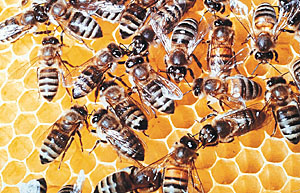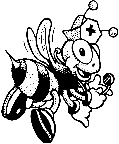| Beat or Prevent Gum Disease
& Tooth Decay
Starting
Today! Honey! Natural Treatment for Gum Disease |
|
There is
quite a bit
of talk going on about the antimicrobial properties of the sweetener,
Xylitol, which is a product manufactured from cornstalks. The
dental hygienist community (discussion groups) is where I am seeing
most of this and my understanding is that it is a pretty good product
as a sweetener and good for your teeth and gums. Something
made
me wonder, however, about going more natural, and 'honey' came to
mind. I wondered about the antimicrobial properties of this
natural and healthy food. What I found really surprised me!
 I was able
to learn
quite a bit about honey's properties in just a few hours - Yes, honey
is a good antimicrobial and has a great number of applications for
treating all sorts of ailments aside from gum disease.
Everything
from eczema to prostate problems are being effectively treated with
honey... Honey! I was able
to learn
quite a bit about honey's properties in just a few hours - Yes, honey
is a good antimicrobial and has a great number of applications for
treating all sorts of ailments aside from gum disease.
Everything
from eczema to prostate problems are being effectively treated with
honey... Honey!Before you run to the cupboard, you should know that the variety of honeys are widely varied in their effectiveness, so not all types are the same. Some honeys may not be any better for your teeth than refined sugar, but at the other end of the spectrum, there are honeys which are outstanding for their antimicrobial properties. It appears that the majority of research on honey's antimicrobial properties and effectiveness in treating gum disease come out of New Zealand in the past half-dozen years. Most of this may be attributable to Dr. Peter C. Molan, Associate Professor of Biochemistry at the University of Waikato, New Zealand: "Honey contains an enzyme that produces hydrogen peroxide which is believed to be the main reason for the antimicrobial activity of honey. Types of honey differ greatly in their antimicrobial potency, varying as much as a hundred fold. The research has shown that honey not only stops the growth of the dental plaque bacteria, it reduces the amount of acid produced, which stops the bacteria from producing dextran. Dextran, a component of dental plaque, is the gummy polysaccharide that the bacteria produce in order to adhere to the surface of the teeth." Honey derived from the Manuka (Leptospermum scoparium) bush, found in abundance in New Zealand, claims the highest potency of antimicrobial properties. In fact, Maruka honey's antibacterial factor is unaffected by enzymes in the body that destroy hydrogen peroxide components. (Normally, peroxide isn't considered a good antimicrobial because the body too quickly dilutes it.) It also has an exceptionally high level of plant-derived antimicrobial activity. Antioxidants in honey prevent the formation of free radicals and the nutrient supply of honey is an important factor in new tissue growth, damaged by infection, as well. In addition, a 'medicinal' honey has been developed in New Zealand and Queensland, Australia to fight against 'superbugs,' such as multiple-resistant staphylococcus aureus (MRSA) and vancomycin-resistant enterococci (VRE), attributable to a reported 100 deaths a week in the UK, according to one report. "Laboratory testing is required to establish the level of anti-bacterial activity in honey. The  honey is
compared with a standard
reference antiseptic (phenol) for potency. So, for example, a honey
with a rating of four would be equivalent in antiseptic potency to a
four percent solution of phenol (carbolic disinfectant).
Honey
should have a rating of four or higher before it can be regarded as a
'Active Honey'. Laboratory tests have shown to be very
effective
against bacteria, the rating should be at least ten but does not need
to be any greater. Honey New Zealand produces a range of
Active
Honeys: Manuka, Rewarewa and Wild Flora. honey is
compared with a standard
reference antiseptic (phenol) for potency. So, for example, a honey
with a rating of four would be equivalent in antiseptic potency to a
four percent solution of phenol (carbolic disinfectant).
Honey
should have a rating of four or higher before it can be regarded as a
'Active Honey'. Laboratory tests have shown to be very
effective
against bacteria, the rating should be at least ten but does not need
to be any greater. Honey New Zealand produces a range of
Active
Honeys: Manuka, Rewarewa and Wild Flora."Manuka honey has UMF (this stands for Unique Manuka Factor) in addition to the usual hydrogen peroxide anti-bacterial activity making it doubly potent. UMF honey is more effective than hydrogen peroxide against some types of bacteria. The level of UMF activity is found in laboratory testing by removing the hydrogen peroxide from the honey and using the same test method for testing an 'active honey'. A rating is found describing the anti-bacterial activity remaining in the honey after the hydrogen peroxide has been removed. This is called Active UMF 10+. UMF is an additional anti-bacterial component that is unique to Manuka Honey. No-one for the scientific discoveries of New Zealand active honeys has so far discovered the substance involved, so it is called UMF." (Honey New Zealand) How is the honey used on the teeth? Some recommend simply rubbing it into the gums after brushing. Since Maruka honey retains it's antimicrobial properties when diluted up to 50 times, it may likely be able to be used as an oral irrigant, when diluted with distilled or filtered water, and injected straight into periodontal pockets using an oral irrigator. (It should be noted that honey is not to be given to infants under 24 months.) If you have an irrigator, you might try it and let us know. If you're already using it, send an email: tom@mizar5.com . For those who would like to see some research, here's a pdf file containing plenty of it: http://bio.waikato.ac.nz/pdfs/honeyresearch/bioactives.pdf In addition, you may go to the Waikato Honey Research Unit web site at: http://bio.waikato.ac.nz/honey/ . All our lives we've been told to stay away from sweets. Maybe now its time to do a hundred and eighty degree on that line of thought - at least with honey, anyway! See Also: The Potential of Honey to Promote Oral Wellness And... Is it really Manuka Honey??  |
| Please see order information. Further information: • UMF is the name of a very beneficial antibacterial property found in some strains of manuka honey. (UMF is not in all manuka honey.) • UMF indicates the honey has a high antibacterial component. • UMF is a guarantee and measure of the antibacterial potency of honey. • UMF Manuka Honey (UMF10 is minimum level) has enhanced antibacterial potency giving it special healing qualities. • UMF Manuka Honey is the preferred honey when selecting honey for special therapeutic uses. • UMF is an industry registered name, trademark, standard indicating antibacterial quality • The UMF standard is the only standard worldwide identifying and measuring the antibacterial strength of honey. UMF was
first discovered by Dr Peter Molan, MBE, of
Waikato
University's Honey Research Unit. There are
Two Types of Manuka Honey: The Name UMF The UMF
Standard is an industry registered standard
indicating which honey has the special UMF property. UMF Guarantee The UMF Rating
Laboratory
Testing of Manuka Honey for UMF Rating: The Test
Results
The UMF
Ratings (measure of antibacterial strength): What Can UMF
Do? 2. Studies are
showing
UMF Manuka Honey with high levels of UMF could be very effective in
helping relieve stomach ulcer symptoms and gastritis, and when applied
topically, in assisting the natural healing of skin ulcers, wounds,
burns, boils, cracked skin, MRSA. But the UMF property is quite stable. OraMedia Home | Articles on Gum Disease | Newsletter Archive | Dr. Robert O. Nara Interview: Freedom From Dental Disease | Healthy Teeth and Gums | 3 Steps to Acheiving Proper Oral Health | Let your Teeth Heal Themselves | How to Eliminate the Dentist From Your Life | Healthy Teeth in Children | FAQ - Frequently Asked Questions | Q&A With a Periodontal Patient | Make Your Own Toothpaste | What Are You Brushing With? (Make your Own Toothpaste Part 2) Subscribe to the OraMedia Newsletter OraMedia Products; Oral Irrigators, Floss, Mouth Rinse, OraMD, Maxiumum Teeth Whitening... Bad Breath and Gingivitis | Is Your Dentist Taking Shortcuts? | How to Become Dentally Self Sufficient Feelings! | Principles of the Seven Factors for Keeping Your Teeth Healthy for Life | Venus, Mars and Oral Hygiene | Via Jet Pro | TheraSol | Glide Floss | OraMD | Maximum Teeth Whitening | BANA Test | 10 Tips for Keeping Your Teeth Healthy for Life! | OraMedia Newsletter Advertizing | Take Bad Breath Seriously | Behavioral Effects of Fluorides on Mass Populations | What is the Best Way to Purify My Water? | Liquid Minerals | Sonicare Elite Bonus Pack 7700 |